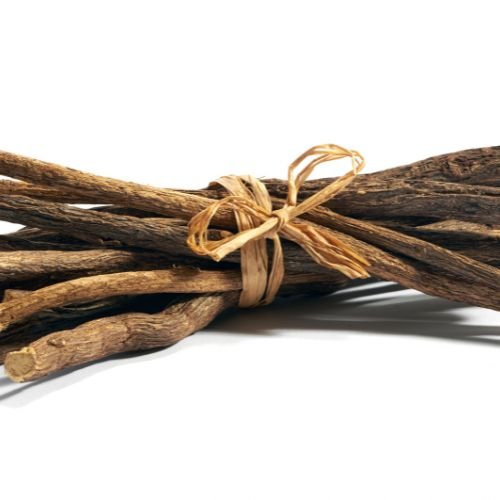Botanical Name
Glycyrrhiza glabra
Origin
Mediterranean & Asia
Key Components
Glycyrrhizin, Flavonoids, Saponins
History & Origin
Licorice root has sweetened and soothed humanity for over 4,000 years, with evidence of its use found in ancient Egyptian tombs, Chinese medicine scrolls, and Mesopotamian tablets. The name "licorice" comes from the Greek "glykyrrhiza," meaning "sweet root," but beyond its famous flavor, this humble root has been treasured as a powerful healing ally for scalp and hair health across civilizations.
Ancient Egyptian papyri describe licorice-infused oils used by temple priestesses to maintain their lustrous hair during ceremonial rituals. The root's cooling properties were believed to calm the "fire" in scalps that led to hair loss and irritation. Queen Hatshepsut's beauty treatments reportedly included licorice root mixed with honey and almond oil for weekly scalp therapy.
In Traditional Chinese Medicine, licorice earned the title "the great harmonizer"—an herb that balanced other herbs while providing its own gentle healing. Chinese court physicians used licorice in hair formulations to soothe scalps irritated by elaborate hairstyling and heavy ornaments, finding that it created the perfect calm foundation for hair growth.
Ayurvedic tradition embraced licorice as "Yashtimadhu," meaning "honey stick," recognizing its ability to cool excess pitta (heat) in the scalp while nourishing hair roots. Ancient Indian texts describe how licorice was combined with coconut oil and rose water to create cooling treatments for those suffering from stress-related hair problems.
Benefits for Hair & Scalp
Licorice root's gentle yet powerful compounds create the ideal scalp environment for healthy hair growth by addressing inflammation, irritation, and stress-related hair issues.
Comforting Scalp Soother
Licorice root calms scalps through:
- Natural anti-inflammatory compounds that reduce scalp irritation
- Cooling properties that soothe heated, stressed scalps
- Gentle demulcent action that protects sensitive skin
- Antimicrobial effects that maintain scalp hygiene
- pH balancing properties for optimal scalp health
Anti-Inflammatory Action
Glycyrrhizin and other compounds provide:
- Cortisol-like Activity: Natural anti-inflammatory effects
- Prostaglandin Inhibition: Reduces inflammatory mediators
- Histamine Regulation: Calms allergic scalp reactions
- Tissue Soothing: Gentle healing for damaged scalp
Stress-Related Hair Support
Natural adaptogenic qualities help with:
- Supporting hair health during stressful periods
- Balancing hormonal effects on hair growth
- Protecting follicles from stress-induced damage
- Creating resilience against environmental stressors
- Promoting relaxation during scalp treatments
Moisturizing & Protective Properties
Natural conditioning includes:
- Mucilaginous compounds that hydrate scalp
- Protective film formation on hair shaft
- Enhanced moisture retention in hair and scalp
- Natural emollient properties for softness
Traditional Wisdom
In Ayurveda, licorice is considered a "Rasayana" (rejuvenative) herb that not only treats current problems but builds long-term vitality. Its sweet taste and cooling energy make it especially valuable for calming "Pitta" conditions in the scalp—heat, inflammation, and irritation that can impede healthy hair growth.
Additional Healing Benefits
Licorice root's therapeutic properties support overall wellness:
- Respiratory Health: Soothing expectorant for coughs and bronchitis
- Digestive Support: Protective for stomach lining and ulcers
- Skin Healing: Anti-inflammatory for eczema and irritation
- Adrenal Support: Adaptogenic properties for stress management
- Liver Protection: Hepatoprotective compounds
- Immune Modulation: Balancing immune system responses
- Antiviral Properties: Traditional treatment for viral infections
How Licorice Root is Used in Hair Care
Traditional Preparation Methods
Traditional practitioners created licorice root decoctions by simmering the dried root for hours to extract its healing essence. In India, fresh licorice juice was mixed with coconut oil and heated gently to create "Yashtimadhu Taila." European herbalists often combined licorice with chamomile and lavender for soothing scalp rinses that calmed irritation while promoting growth.
Classical Applications
- Cooling Scalp Rinses: Decoctions for heated, irritated scalps
- Anti-inflammatory Oils: Root-infused carrier oils
- Soothing Poultices: Ground root mixed with cooling substances
- Stress-Relief Treatments: Combined with adaptogenic herbs
- Gentle Daily Care: Mild preparations for sensitive scalps
Modern Applications
- Sensitive Scalp Formulas: For reactive or allergy-prone scalps
- Post-Chemical Treatments: Soothing after coloring or processing
- Inflammation Reduction: For dermatitis or psoriasis
- Stress-Support Products: During high-stress periods
- Daily Comfort Care: Regular maintenance for scalp health
In REVATOLOGY Products
We source premium licorice root from organic farms in Mediterranean regions where the dry, mineral-rich soil produces roots with maximum glycyrrhizin content. Our gentle extraction methods preserve both the soothing compounds and the natural sweetness that makes licorice root such an effective and pleasant ingredient for scalp care.
Soothing Scalp Rinse Recipe
Simmer 3 tbsp dried licorice root in 2 cups water for 20 minutes. Strain and cool. Add 1 tbsp apple cider vinegar and 5 drops lavender oil. Use as final rinse after shampooing for irritated or sensitive scalps. This traditional preparation calms inflammation while promoting healthy hair growth.
Best Practices & Tips
- Excellent for sensitive or reactive scalps
- Safe for daily use and long-term application
- Particularly beneficial during stressful periods
- Combines beautifully with other soothing herbs
- Fresh root extracts more potent than aged preparations
- Start with diluted preparations for very sensitive scalps
- Natural sweetness makes it pleasant for children
- Avoid if you have high blood pressure (in large amounts)
- Store extracts in refrigerator to maintain potency
- Best results with consistent, gentle application
